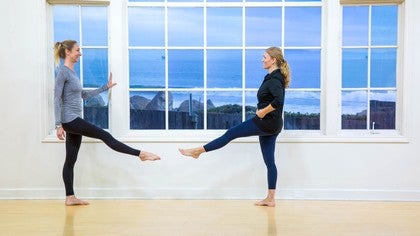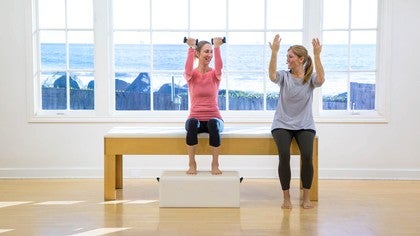Description
About This Video
Transcript
Read Full Transcript
Okay. So welcome today Giuliana here is going to be demonstrating some basic core shoulder, arm and wrist exercises. And what I'd like you to have available would be a towel and a theraband. So let's get started. I'm going to have her lie down on her back. You can do this on a bed or of course a platas table or even a, a nice mat, something that's has a soft surface. Okay?
So what we're gonna start with is her in a nice position where she's lined up feeling her shoulders to her hip lines and hip to hip, shoulder to shoulder. So basically getting as centered as you can while you're lying down. So we're going to start with the core basic exercises. But these are still difficult because what you're going to be doing is starting to strengthen from the inside out. So having your feet hip width apart on the table and slightly closer to your seat just so you have good support. If you're able to do that.
Otherwise you're going to have one leg straight and one knee bent. Chest is open. You want to think is being as broad as you can and we're just going to start with a nice deep breath in. You want to think of the back filling up and then exhale and sink your back down into the floor of the mat. Pulling your navel up. Do that again. Deep breath in and a long breath out.
It's really kind of getting that oxygen moving. Let's do that last time. Throughout the exercises you will breathing at your own pace, but this particular exercise, go ahead and relax. You're going to go into a breathing specific exercise called the hundreds. All right, so what I'll have you do is think of your arms being as long as you can, your chest being as broad as you can, keeping your head down. You're going to take a nice bull five breaths and so it's a really deep breath.
Ly, count to five, three, four, five and then a long exhale for five, four, three, two, one. Again, as you're taking that deep breath and you're thinking of the back, the lungs expanding, Jesse, expanding, exhaling, oh that air out and getting your back to seeing deeper into the floor of the bat, getting those tummy muscles really strong. Do that one more time. Two, three, four, five and you can see her nicely expanding and exhaling. And then hold, hold whole and relax. Breathing naturally again. Okay. If you're able to, I'd like you to lift your arms up or at least the arm that is unaffected and you're going to move that arm and a pumping motion up and down, adding the breath in and a breath out. This warming that's abdominal area up, breathing in. You're also starting to warm your shoulders up.
20 inhaling, two three, four five out, four five. Inhaling, five oh four five 30 we're just going to go to 52 five l four five and last one, two, five, three, four, five. I'll have her rest. These are meant to be done at your own pace and at your own level. So of course always listened to your body and do what it's capable of doing. Okay.
So now what I'll have her start into is what's called a single leg stretch. So I'm going to have you use your arms, but you can go ahead and take one knee into your chest and just kind of give it a nice little pull. So you're stretching the leg, then still holding the leg. If you can, you're going to extend that one leg. Now you may not be as flexible as she is. So what I'll have you do is lower the leg and extended up just to where you feel a stretch. If it's too tight, then obviously keep your knee a little bit bent, but just to where you feel good stretch, you can now rest your hands at your side. But keep the leg up. If you're able to get that leg really long, go ahead and do that.
That's the goal. And hold just for about five counts. Then what I'd like her to do to challenge those core muscles is to actually lower the leg a little bit more, just about two inches. And then here we'll count to three and then about another two inches. So you're challenging your back to maintain those muscles engagement, holding two, three and a little bit lower.
Try and get deeper muscles into that mat. So you're trying to get rid of any space between your back and the man a little bit lower. Try your best not to tense your shoulders or to hold with your arms or your neck. You want to keep that relaxed. Now if you feel like that's too challenging, come up higher at hold. Just hold it for three counts, two, three and then as high as you can and that's going to enable the leg to get a nice long stretch through it. Two, three and then let's bend your knee. Give it a stretch by grabbing the leg.
I know what I'll have you do is switch legs. So first you're going to give to like a stretch, so you'll pull it in and then I'll have you take your leg to where you can. It may not be this high. Maybe down here it may have to have the knee bent, but just where you're getting to let the leg know what's about to happen. And then what I'll have her do is rest your hands at your side if you're able to extend the leg all the way, do so holding for three, two, one and then a little bit lower. So once again, challenging that core powerhouse to maintain a nice strong position and a little bit lower to three. And these are really good exercises to start with to get those muscles to start to, to work at a little bit lower.
And the goal would be to get as low as you can without getting an arch in your back or tension in your neck. And then you'll lift the leg as high as you can, getting that long, long length in the muscle and then bend your knee and give it a stretch. Very good. I'll have you place your leg down, keeping your feet hip width apart. We're going to go into what's called a pelvic lift. If you're able to have both legs, again bent, do so. Otherwise you can always try to do just a little pelvic lift with just one of your legs bent.
So you're going to start by thinking of squeezing your seat. And what I want to make sure is that you don't let your knees fall in. You want to keep your knees pointing straight up, you don't want them to fall out or if they stay parallel. So bottom is squeezing and you're going to start to curl just a few vertebrals off the mat and then you're going to slowly bring that down and let your back Kinda relax here. If the, or even art. And then again they'll do that. Just kind of waking up those pelvic muscles, that pelvic floor and lowering back down and curl.
Don't let your knees roll in. Try to keep them hip with a park and come back down. Now if you feel like that's not hard enough and you want to make that harder, you can come up even higher. Taking a nice deep breath in and come up. And then let's set, truly have you come back down through your middle. Exhaling. Let everything come back down to rest. So again, we can call this bridging as well. You up and then come back down.
Now the next one, I'm going to have her go as high as she can. Her knees are good. She's keeping them hip with the part just as open neck, as long as high as you can. Now to come down. What I want her to think about is really articulating, try to get from the upper back to the middle, back to the lower back to her hips to rest, and about two more. So total of any of the exercises would be 10 no more than 10 representations of anything and start to bring that down. Good control. A lot of times while we're doing these, I'll have you keep going is the hips will wanna waiver and so that's dependent on how strong your legs are, your hips are and your bottom.
So the idea is to get those muscles working and stronger by doing these exercises. However, do one more. I usually like maybe six repetitions and I bring that back down. If you're doing these on a daily basis for about two weeks, you'll feel a difference and rest. Okay. So now that she's done that, we're going to have her do what's called a single a clam. So what we'll have you do is your heels together to the part. And what's great is you can do these lying down.
She's going to keep her knees like that, but now she's going to take one knee. I let it fall to the side, but when she's doing that, what I want you to think about is not letting me opposite hip follow. So in other words, keep your hips flat and then brewering the knee up. So you'll only go to where you can open up the knee without letting that opposite hip follow. So right now she's letting her left knee move. So I don't want her right hip to lift off the mat.
So just be really conscious of that while you're moving and in flooded, you always want to think of resistance. So even though she's not pushing against any way, I want her to think of pushing, getting weight and pulling the leg back up and pushing it away and pulling it back up again. No more than six to 10
It will want to because gravity dictates where it goes right to. She's doing good and again using that resistance to open and come back up.
So what I'll have her do is let both knees open and she's going to actually allow her back to arch or release. When she brings the knees back together, that's where she's going to reengage that powerhouse to go back into what's called the imprinting exercise, where she gets her back to sink down and holds it for about two counts. And then she'll do that about again, 68 times. So using your seat schoolies your bottom and sink deeper intending than that, pulling her navel in and
And two more.
So she's got her knees together for this. You'll keep your knees together, you can move your arms wherever they're comfortable. You can hold on even, and you're gonna let the knees fall one way and you'll look the opposite direction. So your hips will actually lift off the mat, keeping those knees together. She's going to pull them back to center. Net comes back to center and I, she'll go the opposite direction. So I would say one to two sets of these just again, loosening up, waking up those muscles, they feel really good. Last one, and arrest. Okay. The next exercise we're going to nature towel. So let me get that.
So what I'd like you to do, and it's like a bathroom towel or beach towel is role at, so that has a little lift to it. And what we'll have her do is straighten her legs and I'm going to put this underneath her knee. So if I could have you move back a little wort. Good. That's good. And I'm gonna slide this under your knees and you're going to have both like straight, just resting on the towel. It's not a really big move. You could make it bigger. If you wanted to put two towels, you could do that.
It's a pelvic lift is what it is, but your legs are long. But what the towel does is it gives you a little support. So as long as you haven't, yeah, no knee issues, you can do this. You are going to start by squeezing your bottom. Now what I'd like her to do is kind of push her knees into the towel to help lift her hips up and then not just falling down.
You want to control it articulating from your upper back to the middle, back down to the hips and then your rest know do about six of those again or 10 up and lower. And this helps keep the bottom of straw, those legs, Shaw, because we're getting to that. Well, what we're working on is getting to that ability to be able to move more freely so that you can enable yourself to sit up or stand on your own, getting your legs stronger, getting those core muscles stronger. Very good here too. You want to watch balance, making sure the hips don't wobble as your come down and try to go one straight line to rural your spine back down.
I'm going to get rid of the towel because next one I'm going to have you do is set up because we're going to need your theraband for a calf stretch. So let's have you go ahead and set up. You'll still be on the mat. I'm going to grab the theraband and what I'll have her do is she'll have one knee bent and the other leg straight. The straight leg is the one that you're going to put the theraband around your calf and you'll hold on. Good. And what I'd like to see is you sit up as tall as you can.
Not Everybody can sit up the straight. Many times the tighter you are, go ahead and start to round backwards. People will be back here. So you might have to bend this knee just a little bit to get your back to lift. So ideally you want more of the back to be long than the leg to be straight. Just what you're trying to do is feel the stretch on the back of your cat and all it is is a flex at a point of the foot. Yeah. The theraband may move on. Yeah, let's fix that.
So ideally it should support your foot enough that you feel pull. Now, if you can keep those elbows close to your ribs, that's, that's a good idea. And then you're going to hold the flex, grow a little taller in her back and you'll get more stretch and then relax. You can relax your back even. And then you're going to flex and grow tall and then you're going to relax and you're going to flex and grow tall and relax and flex and grow. Talk and relax. And believe it or not, all of these exercises keep going, are not only working your body, but they're working your brain because you have to physically watch what you're doing, paying attention and put focus into it. And maybe one more. Try to hold for maybe three counts, two, three and now you're ready to switch sides. All right, so same thing. One side might be harder than the other.
Generally there's a weaker or stronger side. And what I've looking for is when she goes into the flex is that this part, her for her back grows tall and stays tall.
Are you feeling a stretch on the back of your calf? Okay, good. [inaudible] and here it's just helping also to loosen those muscles, those tight muscles. Cause after an injury or accident, many times the muscles will tighten up and last one address. Now if you didn't have a therapist and you could get along towel, something that was kind of malleable. Okay, so next we're going to go into smart Max or sizes. So what you'll want to do is get a chair or table that she's already happened to be on a table, but because of the height of this table, I'm using a box, but you could use a chair. So I'm going to have her turn. You want to be somewhere where it's stable and where you can sit and your feet are firmly planted on the floor or your knees or level with your hips.
Okay, so what I'm going to have her start with is her feet are hip width apart, her arms, she's going to start with just some wrist stretches. You could, if you had a table, you could put your arms on the table. Otherwise since she, we don't have that for demonstration right now. What I'll have her do is just reach one Armar and she's going to take the opposite arm to hold the wrist. And what I like her to do is kind of push the shoulder forward and pull the shoulder back, push the shoulder forward, and pull the shoulder back and she'll just do maybe five to six of these. So not too, too many. Just getting that shoulder to start to stretch and move many times is we have an effected side, a weaker side, and the other side is stronger.
So using that stronger side to help stretch that affected side, the one that's weaker. And then what I'll have her do, if you're able to a year, your affected side isn't as weak as some. You're going to go to the other side and do the same thing. Stretching the shoulder forward and allowing to retract back, stretch forward and back, sitting as tall as you can or you can rest your back against the chair and forward and back and rest. Okay, so now the next one is she can take the arm, the elbows can be bed and she's going to try to just let the rest, the wrist be relaxed. And then if you're, if you can keep that arm just like that or rest all the table, you'll take your stronger hand and you'll try to stretch the wrist, pulling it back and then you'll push it forward. Today you could hold the hat so you're just stretching the rest up and down. Good. She has a lot of range.
Sometimes we don't, I broke my wrist. I don't have as much range on one side.
But really just getting the wrist to move. And then maybe two more just to have evenness on both sides. Good. And then she'll rest. And now the same here, she'll take her risks. You can hold onto something like, um, like a small towel, something really light. And you're going to twist the wrist. So you can have your fist close or hint fingers to relax however you want.
And you're going to turn the hand out and in and out. And, and this is really good after, for instance, the stroke, Naf, that affected side is not able to do that. Once again, you'll hold it with the unaffected, so the strong hand, you'll hold it and just maneuver it so you can get that flexibility in the hand. Because a lot of times what will happen is the muscles get tight and what we call contract. So the fingers might collect that. Good. And then let's just kind of circle the rest and don't push it. Go to where you have that range. But again, if you do this Mel, it's reverse on kind of a daily basis challenging that it'll get looser so those muscles aren't as rigid and then you would switch and then the unaffected when you could do all by itself.
Actually, that's how their fingers and your, we call them cast mats. You're going to tap their finger to the palm or as close to the palm as you can for 10 counts. One, two, three, five, six, seven, eight, nine, 10 rest. This is good for arthritis too. And take your next finger. So you're working your way through your fingers. 10 pumps, two,
And you can feel you're also working the arms here cause you're holding them up. Add rest. Okay. Now we're going to work on what's called dumbbell curls or just arm curls. You're going to try to keep your elbows glued to your side. If you can have the palms that have the palms up, if you can have the fingers close, have the fingers closed, otherwise you can just relax them and you're gonna think of pulling some dumbbells up to your shoulders, not letting those elbows move and pushing them back down.
So you've seen this in the gym where they're curling those weights up and down. And that's the idea, is to get to the point where we can add weights to this. So you should actually feel those muscles in your arms, the biceps in the triceps working and Corolla. Try to stay tall through this series and lower. You should start to get tired.
Be Amazed at how tired you can get without using any weight at all. [inaudible] add one more up and rest. Let everything relax. Now I'll get out of the way because what I'd like her to do is take her arms up and do the same thing. This time pushing out and it pooling the arms back in. What I'd like to see is that the elbow stay line with the shoulder that as you push out, your elbows don't drop, but they stay level with the shoulder.
The other thing that you want to think about is keeping the chest open, squeeze back, tumor out at squeeze. So if I put my hand here and you had to pull it and I want to see resistance and enter resistance out, always think of that when you're moving, you're pushing, get some weight
If you have one site that's not working as effectively. But the idea is to use the sites that you have to get your body strong and more move mobile. And now let's put those into some circles forward. Just three as big as you can. Go as far back as you can and as far forward as you can without slouching. Try to sit up really tall and then let's reverse that three times
So now what I like to do is, this is more for somebody who's had, while you could do it for anybody who's had like a stroke, where you could also do it for somebody who's had a traumatic brain injury and it's called a reaching exercise so that you want to be somewhere where you're stable. So sitting is a good thing because, and that where a chair isn't going to move on, you want to keep that chair really still. And what you're going to do is I'm going to get the therapy hand again and I'm going to have her reach for it. It helps to have somebody with you during this other ways. You could sit at a table and put some maybe cups, plastic, some plastic cups in front of you or plastic balls, um, and just maybe three of them. And what I would have you do is look forward, keep your gaze forward and I'm gonna put something over to your side and I want you to try to reach for it and I'll keep it, it's fairly close to her so she doesn't have to lean into it. And she'll pull it back. Yeah, I'm going to take it and you're going to reach somewhere else for it.
Pull it back, and then I'm going to put it over here, same hand and pull it back. Good. And then she would repeat that.
So this time I'll go over here.
So you have to actually lean good, and then lean good. And then we'll do the Walmart time. Each side adhere to, you're kind of having to use those. Tell me muscle. You're also getting that ability to be able to move forward and back. And then we'll go to the other side. Okay. So the other arm [inaudible] and then here, and what we'll work on as you progress is doing these in a standing position. And we already did enough to make you work, work extra.
So that would be the start. A good way to start your series until we move to the next series. So you want to stay at this level till you feel like you've gotten enough strength to be able to move forward.
Pilates After Trauma: with Adrianne Crawford
Comments
You need to be a subscriber to post a comment.
Please Log In or Create an Account to start your free trial.


















